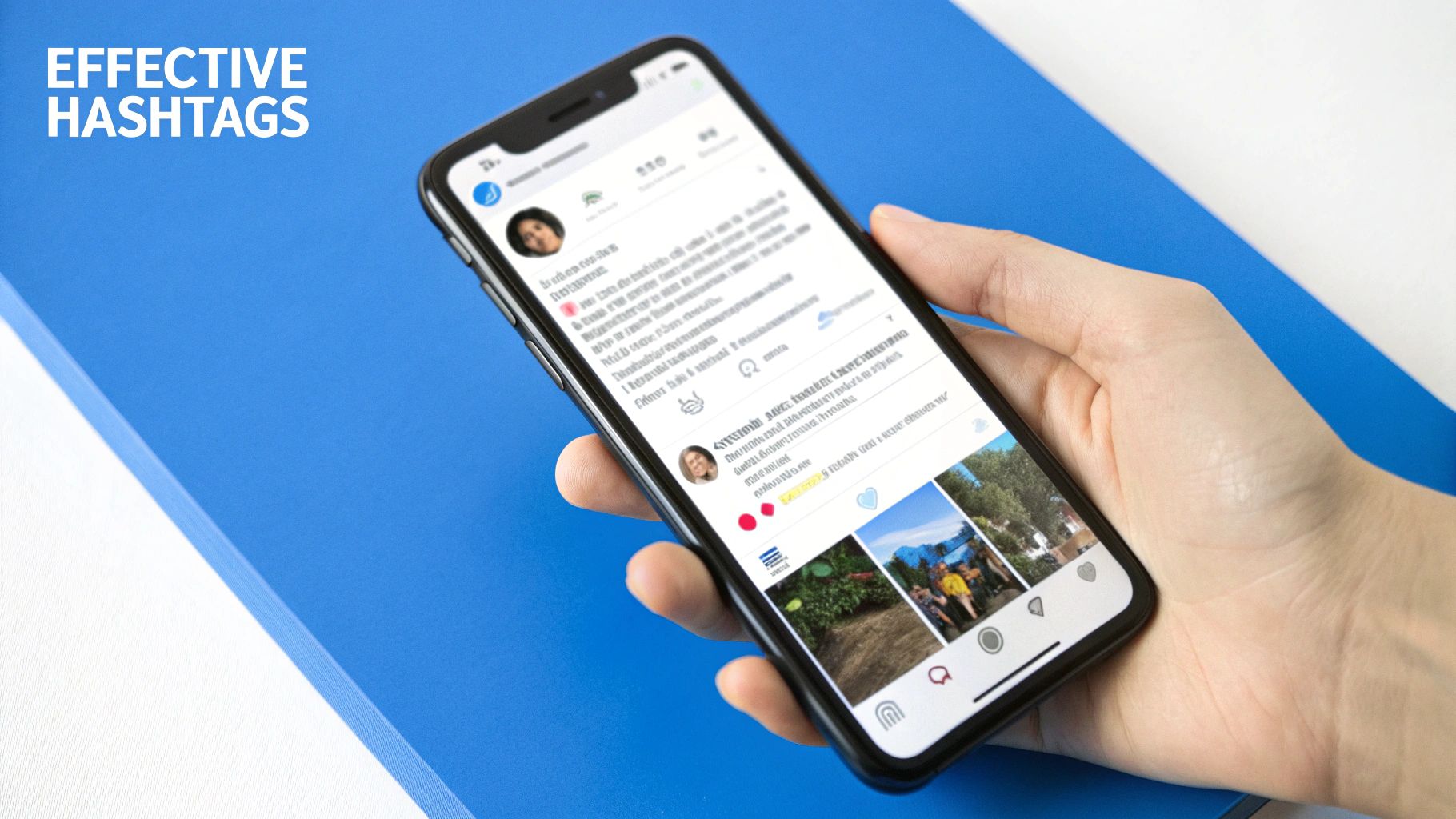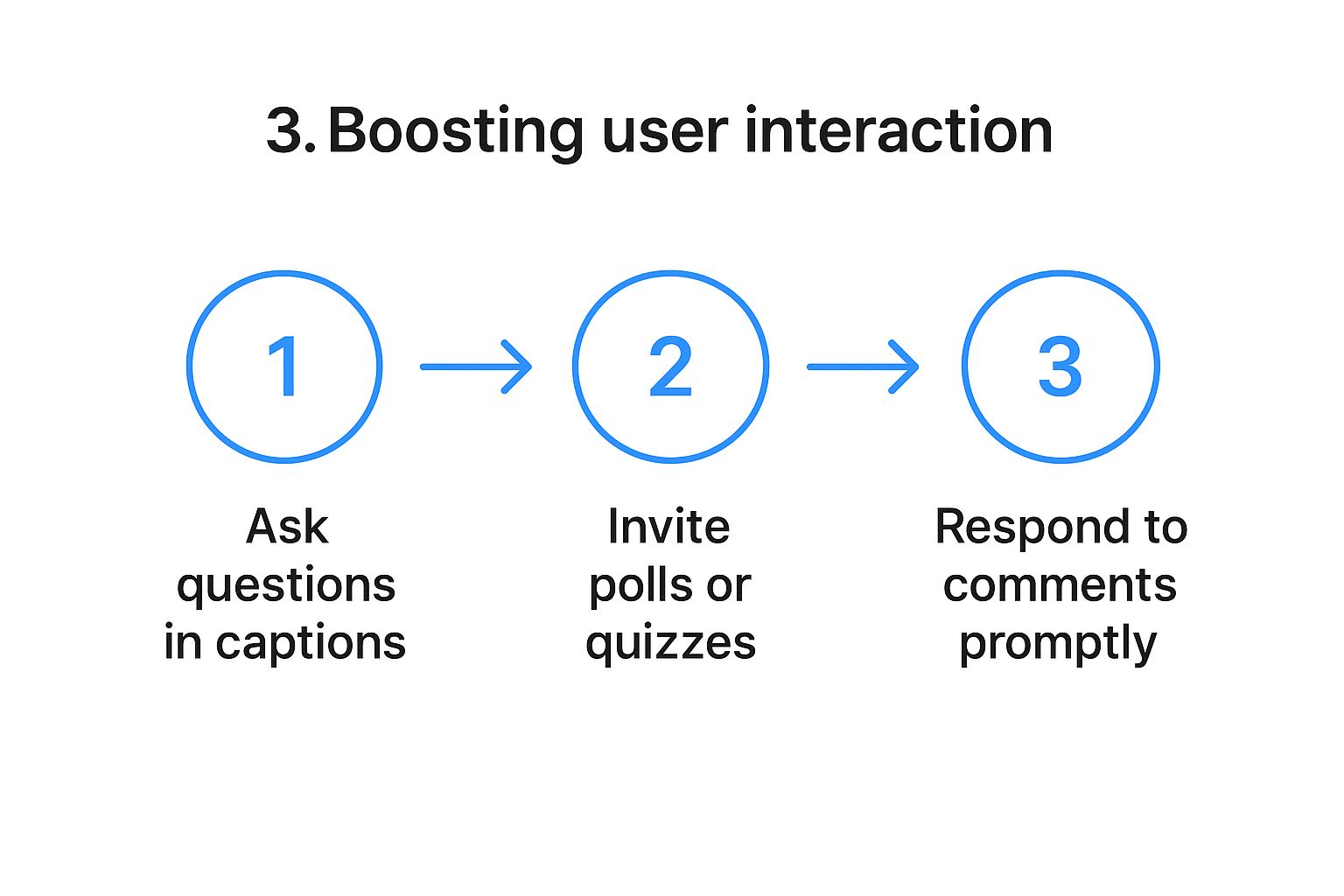If you really want to boost your social media engagement, you have to stop thinking like a broadcaster and start acting like a community builder. It's a fundamental shift. Instead of just pushing content out, your goal is to create posts that actually start a conversation, get involved in those discussions, and figure out what makes your audience want to interact. You need to be a participant, not just a publisher.
Why Engagement Is Your Most Valuable Metric
Let's get one thing straight: social media engagement is far from a vanity metric. In a world run by algorithms, it's the single most important factor for organic reach. Platforms like Instagram, LinkedIn, and TikTok don't just see likes; they analyze every meaningful interaction to decide if your content is good enough to show more people.

When someone takes the time to comment, share, or save your post, they're sending a powerful signal to the platform's algorithm. This tells the system that your content is hitting the mark, which kicks off a positive feedback loop. Your posts get pushed beyond your immediate followers and into discovery feeds, growing your reach without you having to spend a fortune on ads.
The Real Impact of Authentic Interaction
Picture a small e-commerce brand that sells handmade ceramics. For months, they just posted standard product photos. Then, they switched things up. They started sharing behind-the-scenes videos of their creative process, ran polls asking followers to vote on new glaze colors, and featured customer photos in their Stories.
What happened? Their comments section blew up with questions, praise, and genuine excitement. People felt connected to the brand's story, and they went from passive viewers to a loyal community. This explosion in interaction signaled to Instagram's algorithm that the content was high-quality, which led to more visibility on the platform and, you guessed it, more sales. It's a perfect example of how authentic engagement builds relationships that drive real business results.
Engagement is the currency of social media. Each like, comment, and share is a vote of confidence from your audience, telling algorithms that your content is worth amplifying.
Getting Inside the Mind of Today's Social Media User
The data backs this up. The average social media user is active on nearly seven different platforms every month. On top of that, 58% of consumers now discover new businesses through social media—that’s more than through search engines. Engagement isn't just for keeping your current audience happy; it's one of the primary ways new customers will find you.
To help you build a strategy that truly connects, I've found it's best to focus on three core pillars. These concepts are the bedrock of sustainable engagement.
The Three Pillars of Sustainable Engagement
A quick look at the core concepts that drive real interaction on social media, giving you a framework for the tactics that follow.
| Pillar | Core Principle | Key Action |
|---|---|---|
| Value-Driven Content | Your posts must educate, entertain, or inspire. | Focus on solving a problem or sparking an emotion, not just selling. |
| Genuine Community | Social media is a two-way street. | Actively respond to comments, ask questions, and feature user-generated content. |
| User Intent | People use each platform for different reasons. | Tailor your content to match the mindset and expectations of users on each channel. |
Getting these pillars right is what turns passive scrollers into your biggest fans. If you're looking for some immediate, practical ideas to get started, you can dig into these 7 proven strategies to boost social media engagement. This framework will set you up perfectly for the specific tactics we're about to cover.
Creating Content That People Want to Talk About

Real engagement isn't something that just happens by accident; you have to earn it. It all starts when you commit to creating content that people genuinely want to react to, save for later, or send to their friends.
This means you need to go beyond basic demographics and get into the weeds of your audience's psychographics. What are their biggest headaches? What content would actually make their day better, easier, or just more interesting? Nailing down the answers to these questions is the first real step toward making posts that don't just get seen, but actually get people talking.
Building Your Content Pillars
The secret to consistently putting out great stuff is to define your content pillars. Just think of them as the handful of core topics or themes that your brand is going to be known for. The sweet spot is right where your audience's passions and your business expertise overlap.
For example, a B2B tech company could build its entire strategy on just three pillars:
- Industry Innovation: Talking about new tech and where the market is headed.
- Customer Success Stories: Sharing real-world examples of how their product solved a major problem.
- Team Expertise: Giving their engineers and developers a platform to share their own know-how.
These pillars act as a reliable guide, making sure every single post builds your authority while providing real value. To keep things fresh and relevant, it's always a good idea to stay on top of the latest content marketing trends.
Crafting Captions That Spark Conversation
A killer visual can stop someone from scrolling, but it's the caption that actually gets the conversation started. Stop writing captions that just describe the photo or video. Instead, think of every caption as a mini conversation-starter.
Try ending your posts with a simple, open-ended question. Instead of a generic "What do you think?" get more specific. Ask something like, "What’s the one marketing task you wish you could automate away forever?" This small shift invites a much more thoughtful response than a simple "yes" or "no."
Your goal isn't just to post; it's to prompt. Every caption should be an open invitation for your audience to share their own stories, opinions, or questions. That's how you turn a one-way feed into a two-way street.
A Real-World Example of Story-Driven Success
I once worked with a B2B cybersecurity firm that was getting absolutely nowhere. Their feed was a graveyard of dry corporate announcements and dense technical jargon, and their engagement numbers were abysmal. We knew we had to make a change.
So, instead of just posting about product updates, they started telling stories. With client permission (and all details anonymized), they began sharing the nitty-gritty of real security breaches and how their team swooped in to fix them. They transformed these complex case studies into compelling Instagram carousels that walked people through a problem and its solution, step by step.
The results were immediate. Their comments section came alive. Other industry pros and potential clients started jumping in to discuss the scenarios, share similar experiences, and ask incredibly insightful questions. By moving from broadcasting features to telling relatable stories, they saw a huge jump in comments, shares, and eventually, high-quality leads. This kind of human-centric storytelling is at the heart of so many effective https://postonce.to/blog/social-media-growth-strategies, proving it works wonders even in the most technical industries.
Tailoring Your Strategy for Each Platform
One of the most common pitfalls I see brands fall into is the "copy-paste" approach to social media. They create one post and blast it across every single platform. This completely ignores the fundamental reason people use different networks in the first place. To actually get a real boost in social media engagement, you have to meet your audience where they are, with content that fits their mindset in that specific moment.
Put yourself in their shoes for a second. You probably open Instagram for some visual inspiration or a quick laugh. But you log into LinkedIn looking for professional insights or to see what’s happening in your industry. Your content strategy has to respect that huge difference in intent.
Matching Content to User Mindset
Figuring out the "why" behind someone's visit is your golden ticket to higher interaction. People log on for all sorts of reasons, and if you get that, you can create content that feels like it truly belongs there.
Recent data is pretty clear on this. With 5.45 billion global users, the biggest reasons people log on are for social connection (48.7%), catching up on news (34.1%), and finding product inspiration (26.6%). That tells me there's a massive opportunity for content that builds genuine connections and offers up practical ideas. You can dig into more of the game-changing data on Sonary.com if you're curious.
This means you absolutely have to tailor your content. A quick, trend-driven video that pops off on TikTok is almost guaranteed to fall flat on LinkedIn. Over there, a thoughtful text post or a detailed case study carousel is what gets the attention.
Stop asking, "What should I post today?" and start asking, "What does my audience on this specific platform want to see today?" This small shift in perspective is the foundation of a winning cross-platform strategy.
Platform-Specific Engagement Tactics
So, what does this look like in the real world? Let's break down a game plan for a few of the major platforms. Forget one-size-fits-all; we're creating a unique playbook for each.
For Instagram Engagement Instagram is all about the visuals. Aesthetics and storytelling are king. Your entire goal is to create something that stops the scroll.
- Reels for Reach: Jump on trending audio and create short, educational clips. Keep them punchy and packed with value to get in front of new eyeballs.
- Stories for Connection: This is your space for behind-the-scenes content. Use polls, quizzes, and Q&A stickers to start real, two-way conversations with your most dedicated followers.
- Carousels for Education: These are brilliant for breaking down bigger ideas into easy-to-digest, saveable slides. Think of them as mini-presentations that teach your audience something genuinely useful.
For LinkedIn Engagement On LinkedIn, the vibe shifts completely. It's not about entertainment; it's about professional value. People are there to learn, network, and build up their credibility.
- Thought Leadership Posts: Share your unique take on industry news. Don't just report what happened—analyze it. Explain what it means for the people in your network.
- Spark Professional Discussions: Always try to end your posts with a question aimed at your peers. Something like, "What's the biggest challenge you're seeing with remote team management this quarter?" can get a great conversation going.
- Text-Heavy Content: Unlike Instagram, longer, well-written text posts can do incredibly well here. The audience is already in a mindset for a deeper read.
When you start treating each platform as its own little world, you build a presence that truly connects with people and, as a result, drives the engagement you're looking for.
From Followers to a Thriving Community

Let's be real: genuine engagement is so much more than a fleeting like or a quick emoji comment. It's about building a real conversation that turns people who just follow you into die-hard fans. The brands that really kill it on social media aren't just shouting into the void; they're creating a space where their audience actually feels seen and heard.
Turning that follower count into a genuine community all comes down to how you handle every single interaction. It’s about showing up, consistently, and proving you're there to connect, not just to post.
Keep the Conversation Going
Think about how you respond to comments. Just hitting the 'like' button is the digital version of a polite nod—it’s acknowledged, but it doesn't exactly invite a chat.
Instead, look at every comment as a doorway to a conversation. A simple but incredibly effective tactic is to reply with a question. Someone comments, "Love this new feature!" Don't just stop at "Thanks!" Try asking, "Awesome! What's the first thing you're going to do with it?" That one small change keeps the dialogue alive and shows you're actually listening.
A thriving community isn't built on monologues. It’s built on thousands of small, meaningful dialogues that show your audience there's a real person listening on the other side of the screen.
This doesn't just make the original commenter feel valued; it signals to everyone else that this is a place for conversation, encouraging lurkers to jump in. It’s a powerful way to boost engagement without even creating new content. For more platform-specific ideas, our guide on how to get more engagement on Instagram is packed with small tweaks that make a huge difference.
Let Your Audience Create for You
One of the best signs of a healthy, engaged community is when your audience starts making content for you. User-generated content (UGC) is pure gold—it’s authentic social proof and a massive engagement driver.
So, how do you get the ball rolling?
- Create a Branded Hashtag: Come up with a unique, catchy hashtag and ask your followers to use it when they post about your brand. A local coffee shop, for example, could start
#MorningMugMomentsand feature the best customer photos on their own feed. - Run a Fun Challenge: Get your audience involved with a creative challenge. A fitness brand could kick off a 7-day workout challenge, asking people to post their progress and tag them along the way.
Put Your Community in the Spotlight
Ultimately, you want to make your audience the hero of the story. Actively look for chances to celebrate your community members. It can be as simple as a weekly "Fan Photo Friday" or giving a shout-out in your Instagram Stories to someone who left a really thoughtful comment.
When you put your followers in the spotlight, you’re doing more than just creating goodwill. You're showing everyone else that you're paying attention and that getting involved is noticed and rewarded. This creates a positive feedback loop that strengthens loyalty and builds a community that truly lasts.
Using Data to Fuel Your Engagement Strategy
You can create brilliant content and build a real community, but without data, you’re still just guessing. The final piece of the puzzle is letting the numbers guide your decisions. This means looking past surface-level vanity metrics like follower counts and digging into the stats that actually show your audience is paying attention.
Get comfortable with the native analytics tools on each platform—think Instagram Insights, LinkedIn Analytics, or TikTok Analytics. They’re packed with a goldmine of information about what’s truly connecting with your followers. You can pinpoint which posts got the most shares, what formats sparked a conversation, and the exact times your audience is online and ready to engage.
Pinpointing What Really Works
One of the best habits you can get into is a simple monthly audit. Just set aside a little time at the end of each month to look at your best-performing content. And don't just sort by "likes"—that's old-school thinking. Instead, you want to find the posts that signal deeper interest.
Look for patterns in your:
- Most Saved Posts: This is a huge indicator. It tells you your content was so valuable that people wanted to tuck it away for later.
- Most Shared Posts: This is the content that was compelling enough for your audience to vouch for you and send it to their own friends and followers.
- Posts with the Most Comments: These are your conversation starters. They show you what topics and questions get people talking.
When you focus on these metrics, you stop throwing content at the wall to see what sticks. You start intentionally creating more of what your audience has already told you they love. If you're wondering which numbers to track, these 8 Social Media Engagement Metrics for 2025 are a great place to start.
Running Simple Tests to Refine Your Approach
Data also gives you the confidence to experiment. You don't need fancy software to run simple A/B tests to sharpen your strategy. For example, you could post the same photo or graphic twice but with two different captions. Try one that ends with a direct question and another that uses a storytelling prompt, then see which one pulls in more comments.
Little tweaks like this can make a big difference.

The image above lays out a simple but powerful feedback loop: ask, invite, and respond. It’s a foundational concept, but you also have to consider the bigger picture. With over 5.24 billion active social media users across the globe, engagement looks very different from one region to another.
For instance, nearly 97% of internet users in Eastern Asia are on social media, while that number drops to around 30% in Middle Africa. This is a stark reminder that a one-size-fits-all strategy just won't cut it. Your data-driven plan has to account for your specific audience's location and online habits.
Your social media data is your roadmap. It tells you where your audience has been, what they enjoyed along the way, and where they want you to take them next.
By consistently checking your analytics and making small, informed adjustments, you build a sustainable cycle of improvement. This is how you shift from simply hoping for engagement to strategically building it. Ready to go deeper? Check out our guide on https://postonce.to/blog/mastering-social-media-metrics-that-matter.
Got Questions About Boosting Engagement? We've Got Answers.
Even with the best plan laid out, you're bound to run into some real-world questions once you start executing. It happens to everyone. Let's walk through some of the most common things that come up when you're working to get more eyes—and clicks—on your social media.
How Often Should I Actually Be Posting?
This is probably the number one question I hear. Everyone wants a magic number, but the honest answer is there isn’t one. What truly matters is consistency, not just frequency. It’s far better to share three genuinely valuable posts a week than it is to push out ten half-baked ones that your audience just scrolls past.
Your real focus should be on creating content that helps, entertains, or informs your followers. Dive into your analytics to see when your audience is online and active, then schedule your best stuff for those peak times. Always remember, the goal is quality over quantity.
Don't burn out your audience—or yourself—by posting constantly. Find a sustainable rhythm that allows you to maintain high standards, and your followers will reward you for it.
What’s the Best Way to Handle Negative Comments?
Sooner or later, it’s going to happen. Negative comments are just part of putting yourself out there online, but how you handle them says everything about your brand. The absolute key is to respond quickly and professionally. Whatever you do, don't just delete the comment (unless it's clear spam or hate speech, of course).
For legitimate criticism, lead with empathy. Acknowledge their frustration and offer to take the conversation to DMs to sort it out. When your other followers see you handling tough feedback with grace, it shows them you're a mature, customer-first brand that actually listens. That builds a ton of trust.
Do Hashtags Still Work for Engagement?
They absolutely do, but you can't just throw them around randomly. Piling on dozens of generic tags like #business or #marketing is a waste of time. Your content will be buried in a sea of other posts in a matter of seconds.
The trick is to be strategic and specific. Think of it less like shouting into a void and more like joining a targeted conversation. For each post, try a balanced mix like this:
- 1-2 Broad Industry Tags: High-level tags related to your field.
- 3-5 Niche Tags: Get specific to the post's topic (e.g., #B2BContentStrategy).
- 1-2 Branded Tags: These are unique to your company or current campaign.
This simple formula helps your content find the people who are actively searching for your expertise, making them far more likely to engage. Getting this right is a surprisingly powerful way to connect with the right audience.
Ready to stop juggling platforms and start building your community? With PostOnce, you can create your content just once and have it automatically distributed and optimized for all your social networks.
Start saving time and amplifying your reach with PostOnce today